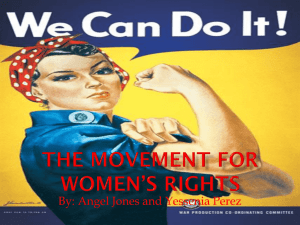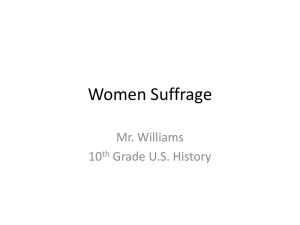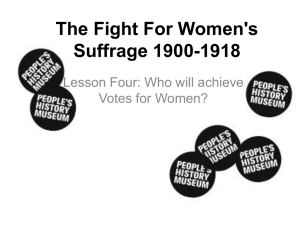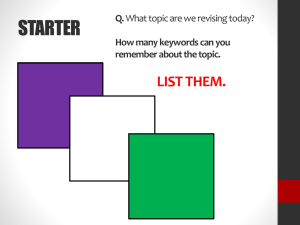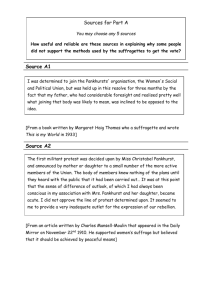Britain 1906-1918 The National Archives Education Service Background and Big
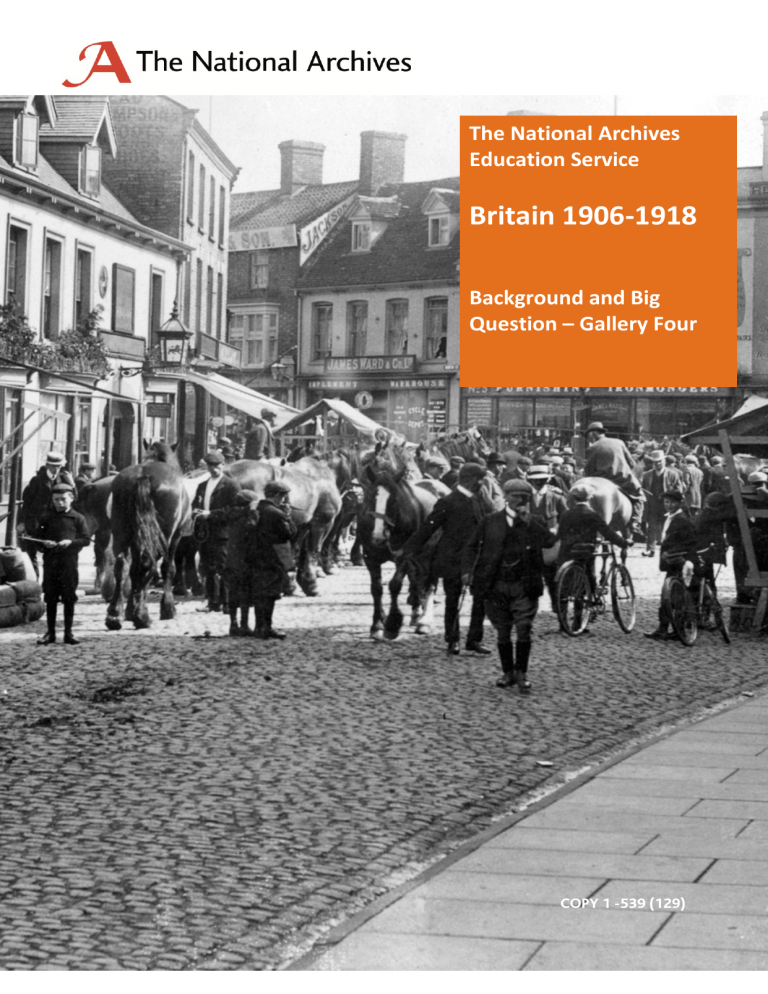
The National Archives
Education Service
Britain 1906-1918
Background and Big
Question – Gallery Four
COPY 1 -539 (129)
Britain 1906-1918 Gallery 4 Background
Contents
CONTENTS ................................................................................................................................................... 2
GALLERY BACKGROUND ............................................................................................................................... 3
W OMEN ' S SUFFRAGE ................................................................................................................................................ 3
S UFFRAGISTS ........................................................................................................................................................... 3
T HE G REAT W AR ...................................................................................................................................................... 4
SOURCES...................................................................................................................................................... 5
B ACKGROUND S OURCE 1 ........................................................................................................................................... 5
B ACKGROUND S OURCE 2 ........................................................................................................................................... 7
B ACKGROUND S OURCE 3 ........................................................................................................................................... 8
B ACKGROUND S OURCE 4 ......................................................................................................................................... 10
GALLERY FOUR: THE BIG QUESTION ........................................................................................................... 11
www.nationalarchives.gov.uk/education/
2
Britain 1906-1918 Gallery 4 Background
Gallery Background
Women's suffrage
The first action to gain female suffrage is generally thought to be in 1832, when a woman asked the campaigners for a wider male vote to include women. From that point on, the cause of women's suffrage was always present in British politics. In 1867 the vote was extended to more of the male population. In the same year a radical young lawyer called Richard Pankhurst tried unsuccessfully to get British courts to accept votes for women.
In 1884 the vote was extended to more men. This started a slow-moving movement of groups and indi- viduals who felt that excluding women from the vote was wrong. Many of those in favour of women's suffrage supported the newly formed Independent Labour Party. Labour generally supported female suffrage and also felt that women voters would support the kind of economic and social reforms that Labour wanted to see. Other campaigners, like the Crewe textile worker Ada Nield and the Lancashire mill workers' leader Selina Cooper, also campaigned by collecting signatures on giant petitions.
Suffragists
In 1897 the various supporters of women's suffrage came together to form the National Union of
Women's Suffrage Societies. The NUWSS (Suffragists) was led by Millicent Fawcett, but it should be stressed that it was a large organisation with many different view- points within it. The NUWSS believed exclusively in constitutional methods of protest. They were prepared to be arrested and put in jail for their cause, but they generally preferred to make their case through petitions, meetings, rallies and publications. Despite their activity, progress was slow. Many Bills involving some mention of female suffrage went before Parliament in the years up to 1906 but none were passed.
It was a difficult issue because there were two questions. The first was whether women should get the vote. The second was which women should get the vote. Not all men had the vote, so there was not much chance all women would get it. However, if only better off women got the vote, then that would hurt the cause of groups like the Labour Party (and many Liberal politicians). They worried that votes for women would help the Conservatives too much.
Background source 1
Front cover of the Suffragist Magazine, October 1909 (HO 45/10338)
Suffragettes
There was another group campaigning for women's suffrage. The wife of (the now dead) Richard
Pankhurst was Emmeline Pankhurst. She and her daughters were frustrated with the lack of achievement as a result of the NUWSS's constitutional action. In 1903 she and other militants formed the Women's Social and Political Union (WSPU). These militants adopted a more radical approach.
They began by disrupting a Liberal Party meeting in 1905. Christabel Pankhurst (Emmeline's daughter) got herself arrested after spitting in the face of a policeman. It was to be the first of many clashes between Suffragettes and police, and the Suffragettes and opponents of their cause.
It was sensational publicity, but did it help or harm the cause? It is very difficult to say and historians still do not agree. What they do know is that from 1906-14 the Suffragists and the Suffragettes campaigned for female suffrage. For much of the time they worked together and supported each other. However, they sometimes clashed, usually when the NUWSS felt that the WSPU went too far with their violent protests.
Background source 2
3
www.nationalarchives.gov.uk/education/
Britain 1906-1918 Gallery 4 Background
Heading of a document relating to an enquiry into clashes between police and Suffragettes
(HO 144/1106/200455)
Campaign for the vote
Key stages in the campaign came in 1910-11, 1913 and 1914. In 1910-11 a Committee of MPs from all parties came up with a Conciliation Bill which would give all women the vote. In 1911-12 it looked as though this would become law, but late in 1912 the Liberals dropped it. The WSPU reacted with a furious campaign of violent protest. This included the destruction of churches and houses of public figures. Other attacks were carried out, including an attempt to disrupt the Derby horse race, which led to the death of the Suffragette Emily Davison.
When arrested, Suffragettes went on hunger strike to protest their cause. The government then responded by force-feeding them. Davison's death and the hunger strikes generated public sympathy for the cause of suffrage, if not support. All the same, by 1914 the vote seemed no nearer.
Background source 3
Handbill for a Suffrage Rally, 1910
(HO 144/1106/200455)
The Great War
In 1914 the campaign took a back seat as Britain went to war. The NUWSS and WSPU immediately dropped their protests and threw themselves into the war effort. The WSPU started high profile campaigns to get men to join the army. The NUWSS work was less spectacular, but it used its organisation to help recruit women workers (and women into the armed forces). At the same time, the
NUWSS kept the pressure on the government to acknowledge what women were doing for the war effort and reward them with the vote.
By 1918 the work of the NUWSS and of course the work of millions of women in industry, farming and the armed forces paid off. In January 1918 the Representation of the People Act gave the vote to all men over the age of 21, women over the age of 30 and women over 21 who were householders or married to householders. About 8 million got the vote. background source 4
Munition workers in the Great War: women's war work had a major effect on attitudes towards female suffrage
(MUN 5/164/1124/40)
4
www.nationalarchives.gov.uk/education/
Britain 1906-1918
Sources
Background Source 1
Front cover of the Suffragist Magazine, October 1909 (HO 45/10338)
Gallery 4 Background
www.nationalarchives.gov.uk/education/
5
Britain 1906-1918 Gallery 4 Background
Transcript
No. I. Vol. I. OCTOBER, 1909. Price Sixpence.
THE FLAG OF FREEDOM.
VOTES FOR WOMEN
Women will next reach the "Poll."
www.nationalarchives.gov.uk/education/
6
Britain 1906-1918 Gallery 4 Background
Background Source 2
Heading of a document relating to an enquiry into clashes between police and Suffragettes
(HO 144/1106/200455)
Transcript
TREATMENT OF THE WOMEN'S DEPUTATIONS BY THE POLICE.
Being a copy of a Memorandum forwarded by the "Parliamentary Conciliation Committee for Woman
Suffrage" to the Home Office, accompanying a request for a public enquiry into the conduct of the police.
www.nationalarchives.gov.uk/education/
7
Britain 1906-1918 Gallery 4 Background
Background Source 3
Handbill for a Suffrage Rally, 1910
(HO 144/1106/200455)
www.nationalarchives.gov.uk/education/
8
Britain 1906-1918 Gallery 4 Background
Transcript
VOTES FOR WOMEN
WOMEN'S SOCIAL AND POLITICAL UNON,
4, Clements Inn.
A
DEPUTATION OF WOMEN
WILL ARRIVE IN
PARLIAMENT SQUARE
At 8 o'clock,
TUESDAY, NOVEMBER 22.
TO LOVERS OF FAIR PLAY!
WOMEN VERSUS THE GOVERNMENT!
Will you come and Umpire?
Read "VOTES FOR WOMEN," Weekly, One Penny, from all
Newsagents and Bookstalls.
www.nationalarchives.gov.uk/education/
9
Britain 1906-1918 Gallery 4 Background
Background Source 4
Munition workers in the Great War: women's war work had a major effect on attitudes towards female suffrage
(MUN 5/164/1124/40)
www.nationalarchives.gov.uk/education/
10
Britain 1906-1918
Gallery four: The Big Question
Gallery 4 Background
THE BIG QUESTION IN THIS GALLERY IS:
WHO SHOULD HAVE PRIDE OF PLACE IN THE
WOMEN’S SUFFRAGE HALL OF FAME?
In 1918 the Representation of the People Act gave the vote to some women. A number of different groups contributed to this achievement:
The militant WSPU (often called Suffragettes)
The moderate NUWSS (often called Suffragists) and a range of organisations linked to them
Women workers in the Great War
Your task in this Big Question is to decide which groups contributed most effectively to achieving the vote for women in 1918. You will need to organise your work into two stages:
Stage 1 Research
Research the case studies in this Gallery and decide which groups made the most important contributions z Look for evidence of the importance of each group in terms of the campaign for the vote
Also, look out for evidence about the combined effect of actions by suffrage campaigners (eg women war workers combined with the NUWSS pushing for the vote during the war)
The research table will help you record what you find out. You can print it out and write on it, or even enlarge it to A3 on a photocopier to give you plenty of space to work. Or, you can download it as a Word file and record what you find out that way.
Stage 2 Online exhibition - Women's Suffrage Hall of Fame
When you have finished your research, you can plan an online exhibition. It will be a Women’s
Suffrage Hall of Fame. The Hall of Fame has 9 exhibits in it. Each will contain a source from case studies 1-4 in this Gallery and a caption written by you explaining what the source shows. Research the case studies in this Gallery and decide which groups made the most important contributions
Look for evidence of the importance of each group in terms of the campaign for the vote *
Also, look out for evidence about the combined effect of actions by suffrage campaigners (eg women war workers combined with the NUWSS pushing for the vote during the war)
The research table will help you record what you find out. You can print it out and write on it, or even enlarge it to A3 on a photocopier to give you plenty of space to work. Or, you can download it as a Word file and record what you find out that way. If you want to save your work and view the exhibition you have created, please log in. You can create an exhibition without logging in, but your work won't be saved after you close your browser.
11
www.nationalarchives.gov.uk/education/
